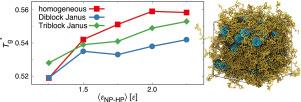Effect of the interaction anisotropy of the nanoparticle surface on the glass transition temperature of polymer nanocomposites
IF 4.1
2区 化学
Q2 POLYMER SCIENCE
引用次数: 0
Abstract
The glass transition temperature, , is one of the most significant factors by which the system is characterized because most of the properties of polymer nanocomposites (PNCs) vary considerably below and above the of PNCs. We performed molecular dynamics simulations on PNCs filled with diblock or triblock Janus nanoparticles (JNPs) to investigate the effect of the interaction anisotropy of the NP surface on by comparing with the results of the case of homogeneous nanoparticles (HNPs) with the same averaged polymer-NP coupling strength over the NP surface. The results revealed that the can be shifted to lower values by introducing anisotropy in the surface interactions, in contrast to NPs with isotropic interactions. Moreover, we investigated the contribution of diffusion coefficients of polymer to the . Adding diblock JNPs (DJNPs) enhanced diffusion of polymers when compared with adding HNPs, thereby lowering the . Comparing the diblock and triblock JNP (TJNP) cases, we found that the polymer diffusion of TJNP cases is slower than that of DJNP cases because the TJNPs can make indirect contact the polymer chains around the entire NP surface.


求助全文
约1分钟内获得全文
求助全文
来源期刊

Polymer
化学-高分子科学
CiteScore
7.90
自引率
8.70%
发文量
959
审稿时长
32 days
期刊介绍:
Polymer is an interdisciplinary journal dedicated to publishing innovative and significant advances in Polymer Physics, Chemistry and Technology. We welcome submissions on polymer hybrids, nanocomposites, characterisation and self-assembly. Polymer also publishes work on the technological application of polymers in energy and optoelectronics.
The main scope is covered but not limited to the following core areas:
Polymer Materials
Nanocomposites and hybrid nanomaterials
Polymer blends, films, fibres, networks and porous materials
Physical Characterization
Characterisation, modelling and simulation* of molecular and materials properties in bulk, solution, and thin films
Polymer Engineering
Advanced multiscale processing methods
Polymer Synthesis, Modification and Self-assembly
Including designer polymer architectures, mechanisms and kinetics, and supramolecular polymerization
Technological Applications
Polymers for energy generation and storage
Polymer membranes for separation technology
Polymers for opto- and microelectronics.
 求助内容:
求助内容: 应助结果提醒方式:
应助结果提醒方式:


